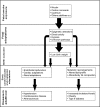Cardiovascular and metabolic influences of fetal smoke exposure
- PMID: 21994150
- PMCID: PMC3218270
- DOI: 10.1007/s10654-011-9621-2
Cardiovascular and metabolic influences of fetal smoke exposure
Abstract
Many epidemiological studies showed associations of low birth weight with cardiovascular disease, type 2 diabetes and obesity. The associations seem to be consistent and stronger among subjects with a postnatal catch up growth. It has been suggested that developmental changes in response to adverse fetal exposures might lead to changes in the fetal anatomy and physiology. These adaptations may be beneficial for short term, but may lead to common diseases in adulthood. Maternal smoking during pregnancy is one of the most important adverse fetal exposures in Western countries, and is known to be associated with a 150-200 g lower birth weight. An accumulating body of evidence suggests that maternal smoking during pregnancy might be involved in pathways leading to both low birth weight and common diseases, including cardiovascular disease, type 2 diabetes and obesity, in adulthood. In this review, we discuss epidemiological studies focused on the associations of maternal smoking with fetal growth and development and cardiovascular and metabolic disease in later life. We also discuss potential biological mechanisms, and challenges for future epidemiological studies.
Figures
References
-
- Oliveira A, Barros H, Azevedo A, Bastos J, Lopes C. Impact of risk factors for non-fatal acute myocardial infarction. Eur J Epidemiol. 2009;24(8):425–432. - PubMed
-
- Heidemann C, Boeing H, Pischon T, Nothlings U, Joost HG, Schulze MB. Association of a diabetes risk score with risk of myocardial infarction, stroke, specific types of cancer, and mortality: a prospective study in the European Prospective Investigation into Cancer and Nutrition (EPIC)-Potsdam cohort. Eur J Epidemiol. 2009;24(6):281–288. - PubMed
-
- Klenk J, Nagel G, Ulmer H, Strasak A, Concin H, Diem G, et al. Body mass index and mortality: results of a cohort of 184, 697 adults in Austria. Eur J Epidemiol. 2009;24(2):83–91. - PubMed
-
- Wiesbauer F, Blessberger H, Goliasch G, Holy EW, Pfaffenberger S, Tentzeris I, et al. Elevated risk of myocardial infarction in very young immigrants from former Yugoslavia. Eur J Epidemiol. 2009;24(11):691–696. - PubMed
Publication types
MeSH terms
Substances
LinkOut - more resources
Full Text Sources
Medical


